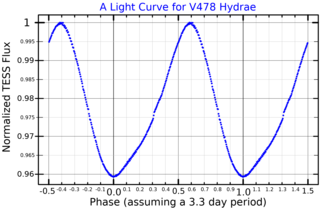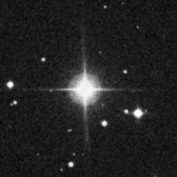Related Research Articles
HD 83443 is an orange dwarf star approximately 134 light-years away in the constellation of Vela. As of 2000, at least one extrasolar planet has been confirmed to be orbiting the star. The star HD 83443 is named Kalausi. The name was selected in the NameExoWorlds campaign by Kenya, during the 100th anniversary of the IAU. The word Kalausi means a very strong whirling column of wind in the Dholuo language.
HD 6434 is a star in the southern constellation of Phoenix. Yellow dwarfs such as this are not very luminous, so at a distance of 138 light years it is not visible to the unaided eye. However, with binoculars it is readily visible under ideal observing conditions, having an apparent visual magnitude of 7.71. The star is drifting further from the Sun with a radial velocity of +23 km/s.
HD 210277 is a single star in the equatorial constellation of Aquarius. It has an apparent visual magnitude of 6.54, which makes it a challenge to view with the naked eye, but it is easily visible in binoculars. The star is located at a distance of 69.5 light years from the Sun based on parallax, but is drifting closer with a radial velocity of −20.9 km/s.
HD 224693, also named Axólotl, is a star in the equatorial constellation of Cetus, and is positioned near the western constellation border with Aquarius. It can be viewed with a small telescope but is too faint to be seen with the naked eye, having an apparent visual magnitude of 8.23. Based on parallax measurements, the object is located at a distance of approximately 306 light years from the Sun. It is drifting further away with a radial velocity of 1.5 km/s.
HD 11964 is a binary star system located 110 light-years away from the Sun in the equatorial constellation of Cetus. It is visible in binoculars or a telescope but is too faint to be seen with the naked eye, having an apparent visual magnitude of 7.51. The system is drifting closer to the Sun with a radial velocity of −9 km/s. Two extrasolar planets have been confirmed to orbit the primary.

HD 70573 is a variable star in the equatorial constellation of Hydra. At a mean apparent visual magnitude of +8.7, this yellow-hued star is too dim to be visible to the naked eye. Based upon parallax measurements, it is located at a distance of 193 light years from the Sun, and is drifting further away with a radial velocity of 20.5 km/s. It is a candidate member of the proposed Hercules-Lyra Association of co-moving stars, although this membership is disputed.

HD 136118 is a star in the Serpens Caput section of the Serpens constellation. The star is too dim to be readily visible to the naked eye, having an apparent visual magnitude of 6.93. It is located at a distance of 165 light years from the Sun based on parallax, and is drifting closer with a radial velocity of −3 km/s.
HD 222582 is a multiple star system in the equatorial constellation of Aquarius. It is invisible to the naked eye with an apparent visual magnitude of 7.7, but can be viewed with binoculars or a small telescope. The system is located at a distance of 138 light years from the Sun based on parallax, and it is drifting further away with a radial velocity of +12 km/s. It is located close enough to the ecliptic that it is subject to lunar occultations.
HD 196050 is a triple star system located in the southern constellation of Pavo. This system has an apparent magnitude of 7.50 and the absolute magnitude is 4.01. It is located at a distance of 165 light-years from the Sun based on parallax, and is drifting further away with a radial velocity of +61 km/s. It is also called by the Hipparcos designation HIP 101806.
81 Ceti is a star located approximately 331 light years away from the Sun in the equatorial constellation of Cetus. 81 Ceti is the Flamsteed designation for this object. It is visible to the naked eye as a dim, yellow-hued point of light with an apparent visual magnitude of 5.65. The star is drifting further away from the Earth with a heliocentric radial velocity of +9 km/s.
HD 30562 is a star in the equatorial constellation of Eridanus. It has a golden hue and can be viewed with the naked eye under good seeing conditions, having an apparent visual magnitude of 5.77. The distance to this star is 85 light years based on parallax. It is drifting further away with a high radial velocity of +77 km/s, having come to within 46.8 light-years some 236,000 years ago.
HD 126614 is a trinary star system in the equatorial constellation of Virgo. The primary member, designated component A, is host to an exoplanetary companion. With an apparent visual magnitude of 8.81, it is too faint to be seen with the naked eye. The system is located at a distance of 239 light years from the Sun based on parallax measurements, but is drifting closer with a radial velocity of −33 km/s.
HD 86226 is a star with a pair of orbiting exoplanet companions, found in the constellation of Hydra. With an apparent visual magnitude of 7.93, it is too dim to be visible with the naked eye. The distance to this system has been determined by the parallax method, yielding a range of 149 light years. It is receding with a heliocentric radial velocity of +19.6 km/s. A survey in 2015 has ruled out the existence of any stellar companions at projected distances above 12 astronomical units.

Chi Ceti , is the Bayer designation for a double star in the equatorial constellation of Cetus. They appear to be common proper motion companions, sharing a similar motion through space. The brighter component, HD 11171, is visible to the naked eye with an apparent visual magnitude of 4.66, while the fainter companion, HD 11131, is magnitude 6.75. Both lie at roughly the same distance, with the brighter component lying at an estimated distance of 75.6 light years from the Sun based upon an annual parallax shift of 43.13 mass.

HD 114613 is a fifth magnitude yellow subgiant that lies 66.7 light-years away in the constellation of Centaurus. The star may be host to a long-period giant planet.
HD 93385 is a star in the southern constellation of Vela. At an apparent visual magnitude of 7.5, it is too faint to be seen with the unaided eye. Parallax measurements made using the Gaia spacecraft show an annual shift of 23.15 mas. This is equivalent to a physical separation of around 141 light years from the Sun. It is drifting further away with a radial velocity of +47.8 km/s.
HD 63399 is an orange hued star located in the southern constellation Puppis, the poop deck. It has an apparent magnitude of 6.45, placing it near the limit for naked eye visibility. Based on parallax measurements from Gaia DR3, the object is estimated to be 445 light years distant. It appears to be receding with a spectroscopic radial velocity of 28.5 km/s. At its current distance, HD 63399 is diminished by 0.29 magnitudes due to interstellar dust.

9 Ceti is a star in the equatorial constellation of Cetus. It has the variable star designation BE Ceti, while 9 Ceti is the Flamsteed designation. It has an apparent visual magnitude of 6.4, which is below the limit that can be seen with the naked eye by a typical observer. Based upon parallax measurements, this star is 69.6 light years away from the Sun.
HD 212771, also named Lionrock, is a solitary star in the southern zodiac constellation Aquarius. It has an apparent magnitude of 7.60, making it readily visible with binoculars but not the naked eye. Parallax measurements place the object at a distance of 364 light years, and is currently receding with a radial velocity of 15 km/s.
HD 72945 and HD 72946 form a co-moving star system in the northern constellation of Cancer. HD 72945 is a binary star that is dimly visible to the naked eye as a point of light with an apparent visual magnitude of 5.91. At an angular separation of 10.10″ is the fainter companion star HD 72946 at magnitude 7.25. It is being orbited by a brown dwarf. The system as a whole is located at a distance of approximately 84 light years from the Sun based on parallax measurements.
References
- 1 2 3 4 5 6 Brown, A. G. A.; et al. (Gaia collaboration) (August 2018). "Gaia Data Release 2: Summary of the contents and survey properties". Astronomy & Astrophysics . 616. A1. arXiv: 1804.09365 . Bibcode: 2018A&A...616A...1G . doi: 10.1051/0004-6361/201833051 . Gaia DR2 record for this source at VizieR.
- 1 2 3 4 5 6 7 Anderson, E.; Francis, Ch. (2012). "XHIP: An extended hipparcos compilation". Astronomy Letters. 38 (5): 331. arXiv: 1108.4971 . Bibcode:2012AstL...38..331A. doi:10.1134/S1063773712050015. S2CID 119257644.
- 1 2 Harlan, E. A. (June 1974). "MK classification for F- and G-type stars. III". Astronomical Journal. 79: 682–686. Bibcode:1974AJ.....79..682H. doi:10.1086/111597.
- 1 2 3 Quarles, Billy; Li, Gongjie; Kostov, Veselin; Haghighipour, Nader (2020), "Orbital Stability of Circumstellar Planets in Binary Systems", The Astronomical Journal, 159 (3): 80, arXiv: 1912.11019 , Bibcode:2020AJ....159...80Q, doi: 10.3847/1538-3881/ab64fa , S2CID 209444271
- 1 2 Houk, N.; Swift, C. (1999). "Michigan catalogue of two-dimensional spectral types for the HD Stars". Michigan Spectral Survey. 5. Bibcode:1999MSS...C05....0H.
- 1 2 3 4 S. G., Sousa; et al. (August 2008). "Spectroscopic parameters for 451 stars in the HARPS GTO planet search program. Stellar [Fe/H] and the frequency of exo-Neptunes". Astronomy and Astrophysics. 487 (1): 373–381. arXiv: 0805.4826 . Bibcode:2008A&A...487..373S. doi:10.1051/0004-6361:200809698. S2CID 18173201.
- 1 2 Stassun, Keivan G.; et al. (March 2017). "Accurate Empirical Radii and Masses of Planets and Their Host Stars with Gaia Parallaxes". The Astronomical Journal. 153 (3): 20. arXiv: 1609.04389 . Bibcode:2017AJ....153..136S. doi: 10.3847/1538-3881/aa5df3 . S2CID 119219062. 136.
- 1 2 Sousa, S. G.; et al. (March 2010). "Higher depletion of lithium in planet host stars: no age and mass effect". Astronomy and Astrophysics. 512: L5. arXiv: 1003.0405 . Bibcode:2010A&A...512L...5S. doi:10.1051/0004-6361/201014125. S2CID 118646949.
- ↑ "79 Cet". SIMBAD . Centre de données astronomiques de Strasbourg . Retrieved 19 August 2017.
- ↑ "Keck astronomers discover planets smaller than saturn" (Press release). Kamuela, Hawaii: W. M. Keck Observatory. March 29, 2000. Retrieved August 13, 2019.
- ↑ Marcy, Geoffrey W.; et al. (2000). "Sub-Saturn Planetary Candidates of HD 16141 and HD 46375". The Astrophysical Journal Letters. 536 (1): L43–L46. arXiv: astro-ph/0004326 . Bibcode:2000ApJ...536L..43M. doi:10.1086/312723. PMID 10849416. S2CID 119530785.
- ↑ Butler, J. T.; et al. (2006). "Catalog of Nearby Exoplanets". The Astrophysical Journal. 646 (1): 505–522. arXiv: astro-ph/0607493 . Bibcode:2006ApJ...646..505B. doi:10.1086/504701. S2CID 119067572.